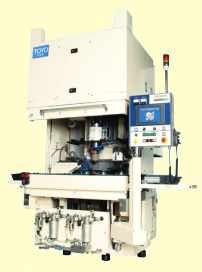2005/07/15 |
Development of the "T-182S"-Japan's
first vertical centerless internal grinding machine
-A compact, high-precision grinding machine suitable for high-diversity, low-volume
production is launched-
Toyo Advanced Technologies Co., Ltd., (Head Office: Minami-ku,
Hiroshima; President: Kenichi Yamamoto) has developed and will
launch the "T-182S," a new vertical internal grinding
machine suitable for high-diversity, low-volume production. The
T-182S is a centerless internal grinding machine that employs
a 2-shoe magnetic vise and is the first vertical type in Japan
(according to an investigation by Toyo).
This unit is designed into a compact size, with machine width reduced to 1,350
mm (less than half that of the horizontal type), so the length of a production
line for bearings can be reduced by about 40%. Also, the T-182S is equipped
with a general-purpose conveyor and swing loader as transfer and loader equipment.
This design enables easy setup changes, and provides high flexibility for high-diversity
low-volume production. Furthermore, the machine is designed to be user-friendly,
with features such as a lift type door to make work easier.
A newly developed high-frequency wheelhead is used for the grinding
wheel spindle that is the core of the machine. The wheelhead has
an established reputation in the internal grinding machine field,
and the output of the high-output type has been increased to a
continuous rating of 23 kW. This enables stable, high-precision
grinding under a variety of grinding conditions. Furthermore, thermal
rigidity has been improved by using a dual head structure and a
column cooling system. High-precision high-efficiency grinding
is achieved using a work spindle swivel mechanism and other innovations.
The system is equipped with the high-functionality interactive "TOYOMATIC-4000" CNC
unit, which has earned an outstanding reputation in Toyo's grinding
machines.

The
T-182S vertical internal grinding machine |
Toyo Advanced Technologies is a top Japanese manufacturer of internal grinding
machines for final finishing of parts, and we have previously developed horizontal
internal grinding machines suited for mass production. Due to diversification
of the market and other trends, Toyo noticed a significant potential for commercialization
of space-saving vertical internal grinding machines suited to high-diversity
low-volume production. As a first step in this direction, we have developed
the T-182S vertical centerless grinding machine designed for machining products
such as medium-sized bearings.
In the area of vertical machines, Toyo manufactures profile grinders
used for machining non-circular parts, but this is our first step
into the market for vertical grinding machines. At present, we
are developing vertical internal grinding machines ranging in size
from small to large (including chucker-type models) and we plan
to market these one after another.
[Main features of the T-182S]
The T-182S is a vertical centerless
internal grinding machine in which the work spindle and grinding
wheel shaft are arranged vertically. The system can grind cylindrical
parts with external dimensions of 240 mm and an inner diameter
of 220 mm. Also, if the column position is offset, it is possible
to set the system to external grinding specifications (although
switching between internal and external grinding with the same
machine is not possible).
- Space-saving
| * |
The width of the machine body is minimized to 1,350
mm using a vertical layout. This is a reduction of about
56% compared to a horizontal type of the same class.
(Width: 1,350 mm, Depth: 2,430 mm, Height: 2,700 mm) |
| * |
Space-saving is realized with the total width of 2,350
mm including even the conveyors that form the transfer
equipment. Assuming use in an inner ring machining line
for taper bearings, line length can be reduced by about
40%. |
- Facilitates setup changes and improves ease-of-work
| * |
One feature of the vertical type is that it uses a highly
versatile conveyor and swing loader because transfer and loading
of machined parts can be performed in the horizontal direction
only. Even if there is a change in the part being machined, the
number of parts to be replaced in the transfer and loader system
is greatly reduced, and this reduces equipment costs and time
needed for setup changes. |
| * |
Hence the system can easily cope with setup changes and line
reconfigurations due to variations in production volume and produced
parts. |
| * |
A lift type door with a wide opening area is used for the
machine body cover, and this greatly improves ease-of-work during
setup changes and maintenance. |
- High-precision, high-efficiency grinding
| * |
We have developed new high-output, high-rigidity, high-frequency
wheelheads. Three types are available: a 10,000 rpm type with
a continuous rating of 23 kW, a 15,000 rpm type with a continuous
rating of 14.6 kW, and a 30,000 rpm type with a continuous rating
of 22 kW. Outstanding grinding performance is achieved due to
the synergistic effect of high output and high rigidity. |
| * |
To counteract thermal displacement, the machine employs a
dual head structure (which has earned an established reputation
in horizontal machines) and a column cooling system that is unique
to the vertical type. As a result, even though the system is
vertical and thus susceptible to the effects of thermal displacement,
it achieves the same grinding precision as a horizontal internal
grinding machine. |
| * |
The work spindle is equipped with a ± 0.25° swivel mechanism,
thereby enabling higher-precision, higher-efficiency machining
of straight holes for taper adjustment. |
| * |
The vertical type employs "Toyo Adaptive Control (TAC)
grinding" - a unique technology from Toyo that has earned
an excellent reputation. The system reduces non-grinding time
and ensures stability in high-precision grinding. |
- Other
| * |
For CNC, the system is equipped with Toyo's own controller,
the "TOYOMATIC-4000." |
| * |
The "TOYOMATIC-4000" is a high-functionality,
interactive-type controller and has a diverse range of
functions, including the ability to store 39 different
programs in memory (thereby improving ease of operation
when there are setup changes), multi-face continuous machining,
and teaching functions. |
|